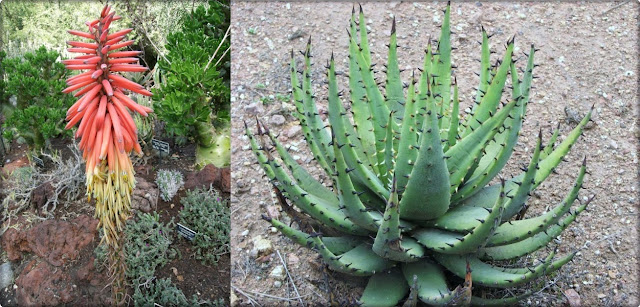Aloe melanacantha (Black-spined Aloe) have the rounded, ball-shaped rosettes, firm brownish-green leaves and the particularly long black thorns on the margins and kee. Plants grow as single rosettes or more often in groups of up to 10 or more dense plants. The stems are short and inconspicuous even in old specimens, hence classified as stem-less aloes. The leaves are narrowly triangular, up to 250 mm long and 40 mm wide at the base, then curving gracefully upwards and inwards resulting in the neat and rounded appearance.
The leaf is a peculiar brown-green that turns a pinkish-red when exposed to prolonged periods of drought and intense heat. The leaves are firm and have a surface that feels rough to the touch. The abundant large black thorns are arranged along the keel and margins of the leaves. The thorns at the leaf bases may be shorter and whitish. Inflorescences are usually simple, up to 1 m (40") high, with a single oblong rosette of about 200 (8") x 80 mm (3"). The flowers are tubular, bright red but turn yellow after opening, and bloom in the winter (May-June).
How to Grow and Care
Aloe is a very forgiving plant, and a well-grown Aloe can be quite beautiful. As with all succulents, it’s essential that Aloe is never allowed to sit in stagnant water, and the plant should be carefully monitored to watch for signs of overwatering.
Hardiness: Hardiness USDA zone 9b: to -3.8 °C (25 °F) 10a: to -1.1 °C (30 °F)
Origin: Aloe melanacantha is endemic to the Namaqualand, in the far west of South Africa.
Soil: Plant Aloes in a well-drained soil specially formulated for cacti and other succulents or make your soil mix. Drainage is essential because too much moisture around roots can cause root rot.
Watering: These succulents do need regular watering but are very tolerant of drought conditions for short periods. Water deeply, but only when the soil is dry. Cut back on watering during the winter months. Overwatering is the top reason Aloe plants die. Do not let water stand in the rosettes.
Fertilizing: Aloes generally do not require fertilizer but may benefit from the extra nutrients. Feed with a fertilizer for cacti and other succulents in spring and summer only. Be sure to follow label directions.
- ALSO READ some more info HOW TO GROW AND CARE ALOE
The leaf is a peculiar brown-green that turns a pinkish-red when exposed to prolonged periods of drought and intense heat. The leaves are firm and have a surface that feels rough to the touch. The abundant large black thorns are arranged along the keel and margins of the leaves. The thorns at the leaf bases may be shorter and whitish. Inflorescences are usually simple, up to 1 m (40") high, with a single oblong rosette of about 200 (8") x 80 mm (3"). The flowers are tubular, bright red but turn yellow after opening, and bloom in the winter (May-June).
- Scientific name: Aloe melanacantha A.Berger
- Common names: Black-thorn aloe, Small mountain aloe
- Family: Asphodelaceae
- Subfamily: Asphodeloideae
- Species: A. Melanacantha
- Genus: Aloe
 |
| source pic: agaveville.org |
How to Grow and Care
Aloe is a very forgiving plant, and a well-grown Aloe can be quite beautiful. As with all succulents, it’s essential that Aloe is never allowed to sit in stagnant water, and the plant should be carefully monitored to watch for signs of overwatering.
Hardiness: Hardiness USDA zone 9b: to -3.8 °C (25 °F) 10a: to -1.1 °C (30 °F)
Origin: Aloe melanacantha is endemic to the Namaqualand, in the far west of South Africa.
Soil: Plant Aloes in a well-drained soil specially formulated for cacti and other succulents or make your soil mix. Drainage is essential because too much moisture around roots can cause root rot.
Watering: These succulents do need regular watering but are very tolerant of drought conditions for short periods. Water deeply, but only when the soil is dry. Cut back on watering during the winter months. Overwatering is the top reason Aloe plants die. Do not let water stand in the rosettes.
Fertilizing: Aloes generally do not require fertilizer but may benefit from the extra nutrients. Feed with a fertilizer for cacti and other succulents in spring and summer only. Be sure to follow label directions.
- ALSO READ some more info HOW TO GROW AND CARE ALOE
 |
| source pic: agaveville.org |
- Jump To:
- Succulents Plants
- Aloe
- Plants
- General Care
- Cultivation
- DIY



